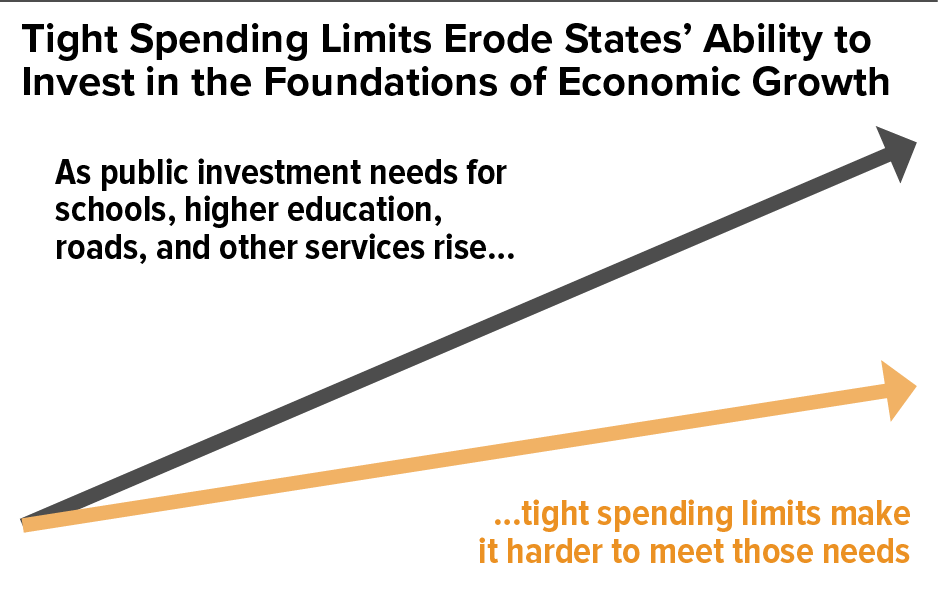- Home
- Constitutional Revenue Limits Can Impede...
Constitutional Revenue Limits Can Impede State Economies
A strong state economy requires high-quality public services like schools, public colleges and universities, and well-maintained infrastructure, among other services. Businesses need well-educated and qualified workers. They need convenient and well-functioning roads, bridges, and ports. And they’re more likely to locate in places with a good quality of life that includes publicly financed amenities like parks and libraries.
Nevertheless, some states are considering building into their state constitutions restrictions on the growth of state revenue that makes such public investments possible. These restrictions can hurt a state’s ability to provide necessary services to its residents and businesses, putting at risk long-term growth and broadly shared prosperity. That’s because constitutional revenue limits can:
Force Harmful Cuts in Critical Services
Tight revenue growth limits, including those that specify a restrictive annual growth percentage or those that base a growth formula on inflation and population growth, can result in the deterioration over time of needed public programs and services. For example, such limits don’t allow revenue to keep up with the actual growth of health care costs, which account for more than one-sixth of states’ expenditures from their own revenue. They also may not allow states to adequately fund their outstanding pension liabilities, or to meet other needs when costs grow in some areas above the limit, squeezing the remaining portions of the budget.
Hinder a State’s Recovery from Recession
Rebounding tax collections during an economic recovery are key to making sure cuts to schools, health care, and infrastructure made during a recession don’t do long-term damage to economic opportunity and growth. When a revenue limit for a given year is calculated by applying a growth factor to the previous year’s revenue, recession-reduced revenues can constrain a state’s ability to provide adequate services for several years after the recession ends. If revenue dropped 12 percent during the recession, for example, but a formula of inflation plus population growth allowed revenue to grow just 3 percent per year, it would take nearly four years just to reach the pre-recession level of revenue. Often called a “ratchet,” this is a particularly constraining feature of a revenue limit.
Increase Borrowing Costs
Bond rating agencies tend to downgrade states that have constitutional revenue limits, leading to higher borrowing costs. In Moody’s state ratings, for example, 30 percent of the score is based on how well a state is managed — and half of that measures a state’s flexibility to respond to situations. For example, it gives one of its lowest flexibility ratings to states with “less than adequate financial flexibility,” including “constitutional constraints that often inhibit budget solutions.” Moody’s explains: “Some states are constitutionally blocked from increasing revenues unless they put a referendum to the voters. Those states often can only look to the expenditure side of their budgets to close deficits when a two-pronged approach would offer more flexibility.”[1]
Impede Investments in the State’s Economy
Strong state economies rely on investments in both physical and human capital — and revenue limits put both at risk. Constrained revenues and more expensive borrowing due to lower bond ratings could limit the state’s ability to invest in infrastructure that could make it a more attractive place to do business. And tight funding is likely also to negatively affect the quality of both K-12 and higher education. Many studies show that the quality of a state’s workforce is a key factor in attracting businesses.
Lessen Accountability of Government and Elected Officials
Voters expect lawmakers to make thoughtful decisions about how their tax dollars are spent, but revenue limits set by a formula can allow elected officials to avoid taking responsibility for the outcomes the revenue limits cause. If programs are cut, they can claim the constrained funding forced the decision. In addition, revenue limits often lead to less transparency, such as by encouraging lawmakers to provide programs or services through tax credits rather than through the normal budget process where they would get regular scrutiny.
Putting revenue limits in a constitution can severely limit elected officials’ ability to respond to unusual circumstances or emergencies. At a time when threats may come from a national financial meltdown, a terrorist action, an epidemic, a weather event, or something else, it is important to preserve the flexibility to respond in a timely way while protecting state residents.
End Notes
[1] Moody’s Investors Service, US States Rating Methodology, April 17, 2013, pp. 7-9, http://www.nasra.org/Files/Topical%20Reports/Credit%20Effects/Moodys_State_Methodology_April_2013.pdf.
